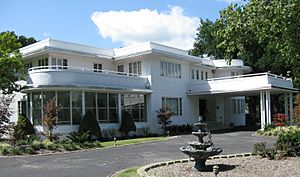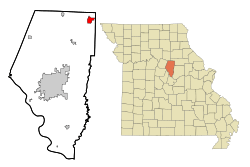Centralia, Missouri facts for kids
Quick facts for kids
Centralia, Missouri
|
||
|---|---|---|
| City of Centralia | ||

Chatol, the A.B. Chance Guest House
|
||
|
||
| Nickname(s):
Anchor City; Prairie Queen
|
||
| Motto(s):
Anchor Capital of the World
|
||

Location of Centralia, Missouri
|
||
| Country | United States | |
| State | Missouri | |
| Counties | Audrain, Boone | |
| Area | ||
| • Total | 2.90 sq mi (7.50 km2) | |
| • Land | 2.90 sq mi (7.50 km2) | |
| • Water | 0.00 sq mi (0.00 km2) | |
| Elevation | 879 ft (268 m) | |
| Population
(2020)
|
||
| • Total | 4,541 | |
| • Estimate
(2023)
|
4,802 | |
| • Density | 1,568.02/sq mi (605.33/km2) | |
| Time zone | UTC-6 (Central (CST)) | |
| • Summer (DST) | UTC-5 (CDT) | |
| ZIP code |
65240
|
|
| Area code(s) | 573 | |
| FIPS code | 29-12898 | |
| GNIS feature ID | 2393789 | |
Centralia is a city in the U.S. state of Missouri. Most of the city is in Boone County. A very small part is in Audrain County.
In 2020, about 4,541 people lived in Centralia. The main part of Centralia is considered part of the Columbia metropolitan area. The smaller part in Audrain County is near Mexico.
Contents
Discover Centralia's Location
Centralia is located in the state of Missouri. It covers a total area of about 2.90 square miles (7.50 square kilometers). All of this area is land.
Centralia's Population Over Time
The number of people living in Centralia has changed over the years. Here's a look at the population from 1880 to 2020:
| Historical population | |||
|---|---|---|---|
| Census | Pop. | %± | |
| 1880 | 703 | — | |
| 1890 | 1,275 | 81.4% | |
| 1900 | 1,722 | 35.1% | |
| 1910 | 2,116 | 22.9% | |
| 1920 | 2,071 | −2.1% | |
| 1930 | 2,009 | −3.0% | |
| 1940 | 1,996 | −0.6% | |
| 1950 | 2,460 | 23.2% | |
| 1960 | 3,200 | 30.1% | |
| 1970 | 3,623 | 13.2% | |
| 1980 | 3,537 | −2.4% | |
| 1990 | 3,414 | −3.5% | |
| 2000 | 3,774 | 10.5% | |
| 2010 | 4,027 | 6.7% | |
| 2020 | 4,541 | 12.8% | |
| source: | |||
Who Lives in Centralia?
In 2010, there were 4,027 people living in Centralia. Most residents were White (96.5%). About 1% were African American, and smaller groups were Native American or Asian. About 1.6% of the population was Hispanic or Latino.
The average age in Centralia was 38 years old. About 26.6% of the people were under 18. About 17.7% were 66 years old or older.
Learning in Centralia: Schools and Library
The Centralia R-VI School District runs four schools for students of different ages:
- Chance Elementary School (grades PK-2)
- Centralia Intermediate School (grades 3–5)
- Chester Boren Middle School (grades 6–8)
- Centralia High School (grades 9–12)
Centralia Intermediate School is the newest building. It opened in 2009 to help with more students joining the district. This school has 15 classrooms, each with many computers.
The town also has a place to borrow books, called the Centralia Public Library.
Centralia's Past: A Look at History
Centralia has an interesting history, from its beginnings to important events and businesses.
How Centralia Got Its Name
Centralia was founded in 1857. It got its name because it was in the center of a railroad line. It was also in the middle of a large prairie area. This prairie was between several other towns like Mexico and Huntsville.
The Civil War and Centralia
A sad event happened in Centralia during the American Civil War. On September 27, 1864, a group of Confederate fighters attacked a train. They took 22 unarmed Union soldiers from the train and killed them. This group was led by William T. "Bloody Bill" Anderson.
Later, a Union force chased these fighters. The Union soldiers were ambushed, and about 150 of them were killed. This event is known as the Centralia Massacre.
The A.B. Chance Company: A Local Success Story
The A.B. Chance Company started in Centralia in 1907. It was founded by Albert Bishop Chance. He invented the first useful earth anchor, which is a device used to hold things firmly in the ground.
This company has been very important to Centralia's growth. For over 100 years, Chance has made many products. These include tools and equipment for the electricity industry worldwide. The company was bought by Hubbell in 1994. The Chance brand products are still made in Centralia.
Today, the A.B. Chance Company is still a big part of Centralia's economy. It employs about 860 people.
Historic Places in Centralia
Some places in Centralia are so important that they are listed on the National Register of Historic Places. These include:
- Albert Bishop Chance House and Gardens
- Chatol
Anchor Fest: A Fun Community Event
Because of Centralia's history with earth anchors, the city holds a yearly celebration called Anchor Fest. It usually happens the weekend after Memorial Day.
Anchor Fest is a great way to start the summer. People can enjoy rides, tasty food, and funnel cakes. There are also arts and crafts, and live music. A parade features high school bands, local groups, tractors, and classic cars.
Media in Centralia
Centralia is in the area where TV and radio stations from Columbia and Jefferson City can be received.
Centralia also has its own radio stations:
- KMFC 92.1 FM: This station is part of the K-Love network.
- KSDC-LP 94.9 FM: This station is an affiliate of Radio 74 Internationale.
Famous People From Centralia
Centralia has been home to some notable individuals:
- Albert Bishop Chance: He invented the earth anchor. He was also a mayor and founded the A.B. Chance Company.
- Cheryl Burnett: A successful college basketball coach who led teams to the Final Four.
See also
 In Spanish: Centralia (Misuri) para niños
In Spanish: Centralia (Misuri) para niños


